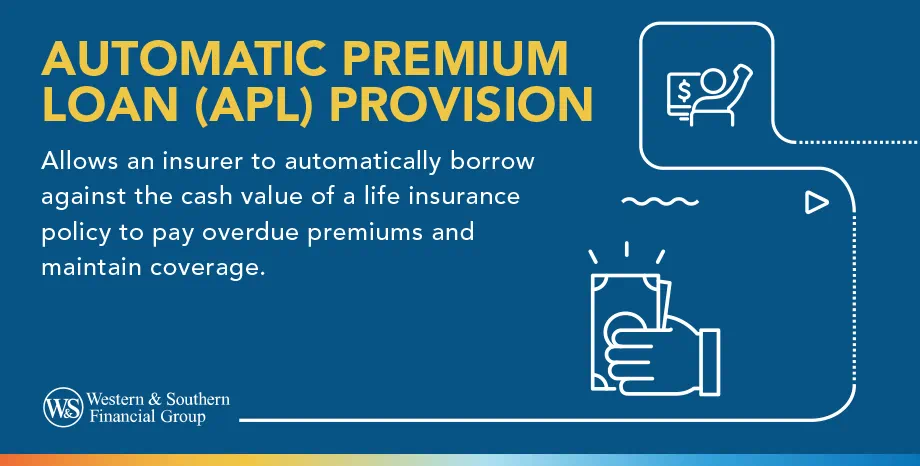

Key Takeaways
- APL provisions prevent policy lapses by using the cash value to cover missed premium payments.
- Loans taken under the APL provision accrue interest, which increases the total amount owed over time.
- Using the cash value to pay premiums decreases both the savings component and the potential growth of the policy.
- Regular monitoring and management of the policy are essential to avoid unintended consequences.
- Policyholders can repay the loan at their convenience, impacting both the cash value and the death benefit.
What is an Automatic Premium Loan Provision?
An automatic premium loan (APL) provision is a feature in many cash-value life insurance policies designed to prevent a policy from lapsing due to a missed premium payment. This insurance policy provision automatically uses the permanent life insurance policy's cash value to pay the overdue premium, ensuring continuous coverage.
How Does an Automatic Premium Loan Work?
Activation of the Provision
- Inclusion in Policy: The life insurance policy must include the automatic premium loan provision clause when issued. This feature is not always standard, so policyholders must ensure it is part of their policy if they desire this protection. Depending on your life insurance company, some life policies may allow it to be added later.
- Missed Premium Payment: The provision automatically activates when a policyholder misses a premium payment. There is typically a grace period (e.g., 30 days) during which the policyholder can pay any outstanding premium before the APL kicks in.
Utilizing the Cash Value
- Loan Against Cash Value: The APL uses the policy's accumulated cash value to pay the overdue premium payment. The insurance company essentially grants a loan to the policyholder, using the policy cash value as the loan collateral.
- Sufficient Cash Value: For the APL to work, the policy must have enough cash value to cover the premium amount overdue. If the cash value is inadequate, the policy may still lapse.
Loan Repayment Terms
- Interest on Loan: Like any other standard loan, the amount borrowed from the cash value is subject to interest. The interest rate is specified in the policy terms.
- Repayment Options: The policyholder can repay the loan anytime to restore the cash value. If the loan is not repaid, the outstanding loan amount plus interest will be deducted from the policy's death benefit when the insured passes away.
Policy Impact
- Reduced Cash Value: Borrowing from the cash value reduces the amount available in the policy's savings component, potentially impacting its growth potential and future borrowing capacity.
- Potential Policy Lapse: If subsequent premiums are also missed and the cash value is depleted, the policy may ultimately lapse despite the APL provision.
Example Scenario
Consider a whole life insurance policyholder with an accumulated cash value of $5,000. The policy's annual premium is $1,000. If the policyholder misses a premium payment, the APL provision automatically takes a $1,000 loan from the cash value to cover the policy premium, keeping the policy active. The policyholder is then charged interest on the $1,000 loan, which they can repay at their convenience.
Safeguard your policy with an automatic premium loan provision. Get a Free Life Insurance Quote
Pros: Benefits of Automatic Premium Loan Provisions
Automatic premium loan (APL) provisions offer several significant for life insurance policyholders, ensuring that their coverage remains intact even when premium payments are missed. Here's a detailed look at the advantages:
Prevents Policy Lapse
- Continuous Coverage: An APL prevents a life insurance policy from lapsing due to non-payment, thereby protecting the policyholder's beneficiaries.
- Grace Period Extension: By automatically covering missed payments, the APL provides additional time for the policyholder to manage their finances without losing their insurance coverage.
Financial Security
- Assurance of Stability: Knowing that the policy remains active despite a missed payment reassures policyholders that their families are financially protected. They can be confident that their coverage stays intact, even during financial difficulties.
- Automatic Protection: The APL provision works automatically, reducing the stress of managing payment schedules by eliminating the need for policyholders to take immediate action if they miss a payment.
Utilizes Policy Cash Value
- Effective Use of Savings Component: The APL uses the policy's cash value, a built-in savings component of many whole life insurance policies. This feature leverages the policy's accumulated value to maintain coverage.
- Collateral for Loans: The cash value acts as collateral for the loan, ensuring that the policy remains active without requiring external financing. No credit application or credit check is required.
Flexibility in Repayment
- No Immediate Repayment Required: Policyholders are not required to repay the loan immediately. If the outstanding loan amount, including interest, is not repaid during the policyholder's lifetime, it is deducted from the policy's death benefit.
- Repayment Options: Policyholders can repay the loan at their convenience, restoring the cash value and reducing the impact of interest on their policy's value.
Maintains Policy Benefits
- Protects Death Benefit: By keeping the policy in force, the APL ensures the intended death benefit will be paid to beneficiaries, protecting the financial legacy planned for their loved ones.
- Retains Additional Features: Many life insurance policies come with additional features and benefits, such as riders for terminal illness or disability. An active policy ensures that these benefits remain available.
Cons: Drawbacks of Automatic Premium Loan Provisions
While automatic premium loan (APL) provisions offer several benefits, they also come with certain drawbacks that policyholders should be aware of. Here are the key disadvantages:
Accrual of Interest
- Interest Charges: When an automatic loan covers a premium, the borrowed amount accrues interest, causing the policyholder to owe more than the premium over time.
- Compounding Interest: The interest on the loan can compound, leading to a significant increase in the amount owed if the loan is not repaid promptly.
Reduction in Cash Value
- Depleted Savings Component: Using the policy's cash value to cover missed premiums depletes savings, potentially hindering policy growth and reducing available cash for future loans or withdrawals.
- Impact on Policy Performance: A lower cash value can affect the overall performance of the policy, including any dividends or interest earned on the policy.
Potential for Policy Lapse
- Insufficient Cash Value: If the cash value is inadequate to cover the missed premiums and the loan interest, the policy may eventually lapse despite the APL provision.
- Multiple Missed Payments: Continuous reliance on the APL provision for multiple missed payments can quickly deplete the cash value, increasing the risk of policy lapse.
Reduced Death Benefit
- Loan Repayment from Death Benefit: If the loan is not repaid during the policyholder's lifetime, the outstanding loan amount plus interest will be deducted from the death benefit, reducing the amount the beneficiaries receive.
- Impact on Legacy: A reduced death benefit can impact the financial legacy the policyholder intended to leave for their loved ones.
Complexity and Misunderstanding
- Understanding Loan Provisions: The mechanics of the APL provision, including interest accrual and impact on cash value, can be complex and challenging for policyholders to understand fully.
- Mismanagement Risk: Policyholders might mismanage their policy without proper understanding, leading to unintended financial consequences.
How to Set Up an Automatic Premium Loan Provision
Setting up an automatic premium loan (APL) provision in a life insurance policy involves several steps. Here's a detailed guide to help you through the process:
Step 1. Selecting The Right Policy
- New Policy Selection: Ensure that you select a life insurance policy that offers the option to include an automatic premium loan (APL) provision.
- Existing Policy Inclusion: Check if your current life insurance policy includes an APL provision, typically found in the policy's terms and conditions.
- Policy Type: APL provisions are typically available in whole life insurance policies, so ensure your policy type supports this feature.
Step 2. Consult with Your Insurance Provider
- Contact Your Agent: Contact your life insurance agent or company representative to discuss the APL provision. They can provide detailed information about how it works and its implications for your specific policy.
- Ask Questions: Inquire about fees, interest rates, and potential impacts on your policy's cash value and death benefit. Make sure you fully understand the terms and conditions.
Step 3. Request Policy Amendment
- Formal Request: If your current policy lacks an APL provision, you may need to request an amendment, which could involve completing additional paperwork or applications.
- Underwriting Process: Some insurance companies may require underwriting approval for amendments, especially if it involves changing significant policy features.
Step 4. Understand the Terms
- Interest Rates: Familiarize yourself with the interest rates applied to loans under the APL provision. These rates can vary and impact the overall cost of the loan.
- Repayment Conditions: Know the conditions for repaying the loan. Understand how the unpaid loan affects your policy's cash value and death benefit.
Step 5. Confirm Activation
- Policy Documentation: Ensure the APL provision is officially added to your policy documentation. Then, review the updated policy to confirm that the provision is active and correctly described.
- Record Keeping: Keep a copy of all correspondence and updated policy documents for your records, as this will be important for future reference and any potential claims.
Step 6. Monitor Your Policy
- Regular Review: Monitor your policy statements for cash value, outstanding loans, and interest accrued to stay informed about your policy's status and potential issues.
- Financial Planning: Consider how the APL provision fits your broader financial planning. Regularly assess your ability to make premium payments and repay loans to avoid unnecessary interest accumulation.
Conclusion
Automatic premium loan provisions are a valuable feature that ensures your life insurance policy remains active even if you miss a premium payment. Understanding how they work and setting them up correctly can protect your coverage and help provide financial security for your loved ones.
Talk to an expert about your life insurance options. Get a Free Life Insurance Quote
Frequently Asked Questions
Will an automatic premium loan decrease the death benefit of a policy?
Yes, an automatic premium loan can indirectly decrease a policy's death benefit. While the APL doesn't reduce the death benefit, any outstanding loan balance, including accrued interest, will be deducted from the payout when the insured passes away.
Is a policy loan the same as a premium loan?
No, a policy loan and a premium loan are not the same. A policy loan allows the policyholder to borrow money against the cash value of their life insurance policy for any purpose. In contrast, a premium loan specifically uses the cash value to cover missed premium payments to keep the policy from lapsing. Both loans accrue interest and must be repaid to avoid reducing the policy's death benefit.
Footnotes
- Withdrawals may be subject to charges, withdrawals of taxable amounts are subject to ordinary income tax, and, if taken before age 59½, may be subject to a 10% IRS penalty.
- Interest is charged on loans. They may generate an income tax liability, reduce the Account Value and the Death Benefit, and may cause the policy to lapse.

















































